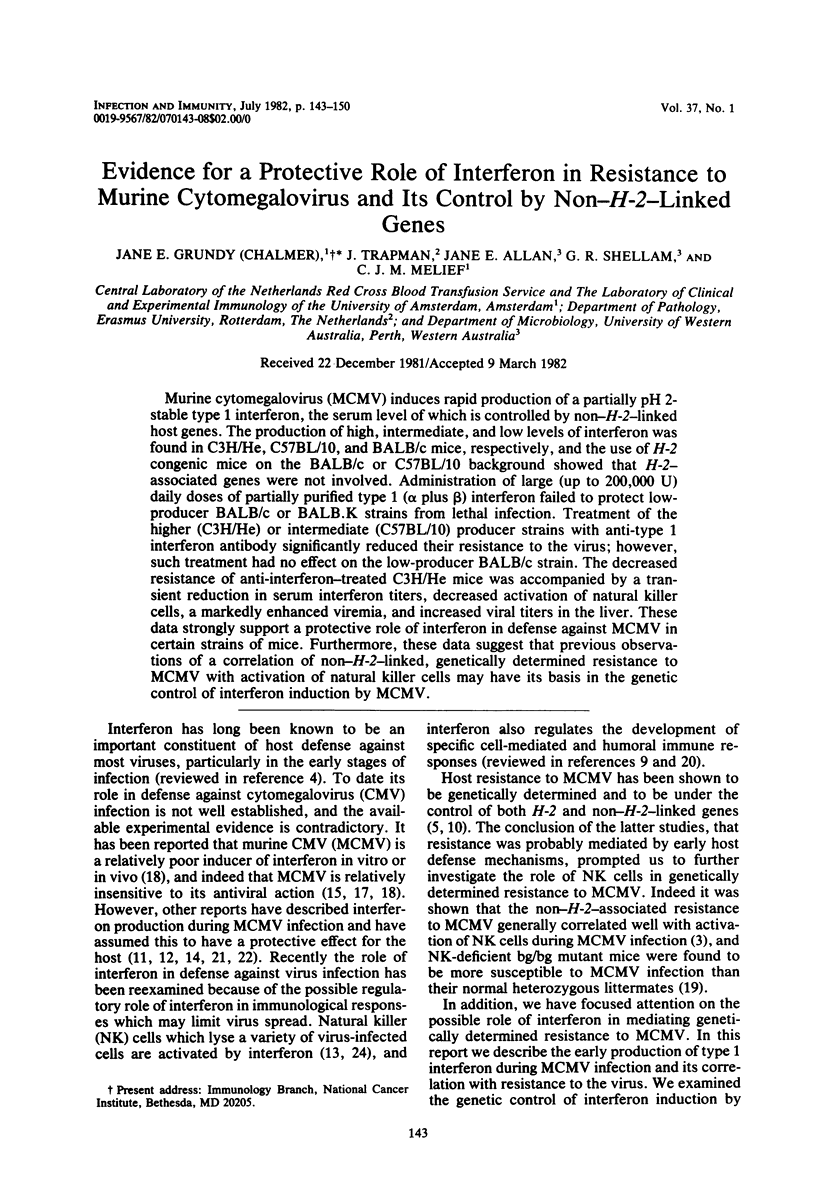Abstract
Murine cytomegalovirus (MCMV) induces rapid production of a partially pH 2-stable type 1 interferon, the serum level of which is controlled by non-H-2-linked host genes. The production of high, intermediate, and low levels of interferon was found in C3H/He, C57BL/10, and BALB/c mice, respectively, and the use of H-2 congenic mice on the BALB/c or C57BL/10 background showed that H-2-associated genes were not involved. Administration of large (up to 200,000 U) daily doses of partially purified type 1 (alpha plus beta) interferon failed to protect low-producer BALB/c or BALB.K strains from lethal infection. Treatment of the higher (C3H/He) or intermediate (C57BL/10) producer strains with anti-type 1 interferon antibody significantly reduced their resistance to the virus; however, such treatment had no effect on the low-producer BALB/c strain. The decreased resistance of anti-interferon-treated C3H/He mice was accompanied by a transient reduction in serum interferon titers, decreased activation of natural killer cells, a markedly enhanced viremia, and increased viral titers in the liver. These data strongly support a protective role of interferon in defense against MCMV in certain strains of mice. Furthermore, these data suggest that previous observations of a correlation of non-H-2-linked, genetically determined resistance to MCMV with activation of natural killer cells may have its basis in the genetic control of interferon induction by MCMV.
Full text
PDF







Selected References
These references are in PubMed. This may not be the complete list of references from this article.
- Armstrong J. A. Semi-micro, dye-binding assay for rabbit interferon. Appl Microbiol. 1971 Apr;21(4):723–725. doi: 10.1128/am.21.4.723-725.1971. [DOI] [PMC free article] [PubMed] [Google Scholar]
- Arnheiter H., Haller O., Lindenmann J. Host gene influence on interferon action in adult mouse hepatocytes: specificity for influenza virus. Virology. 1980 May;103(1):11–20. doi: 10.1016/0042-6822(80)90122-1. [DOI] [PubMed] [Google Scholar]
- Bancroft G. J., Shellam G. R., Chalmer J. E. Genetic influences on the augmentation of natural killer (NK) cells during murine cytomegalovirus infection: correlation with patterns of resistance. J Immunol. 1981 Mar;126(3):988–994. [PubMed] [Google Scholar]
- Chalmer J. E., Mackenzie J. S., Stanley N. F. Resistance to murine cytomegalovirus linked to the major histocompatibility complex of the mouse. J Gen Virol. 1977 Oct;37(1):107–114. doi: 10.1099/0022-1317-37-1-107. [DOI] [PubMed] [Google Scholar]
- Dawkins H. J., Shellam G. R. Augmentation of cell-mediated cytotoxicity to a rat lymphoma. I. Stimulation of non-T-cell cytotoxicity in vivo by tumour cells. Int J Cancer. 1979 Aug;24(2):235–243. doi: 10.1002/ijc.2910240216. [DOI] [PubMed] [Google Scholar]
- De Maeyer E., De Maeyer-Guignard J. Influence of animal genotype and age on the amount of circulating interferoh induced by Newcastle disease virus. J Gen Virol. 1968 May;2(3):445–449. doi: 10.1099/0022-1317-2-3-445. [DOI] [PubMed] [Google Scholar]
- Grundy J. E., Mackenzie J. S., Stanley N. F. Influence of H-2 and non-H-2 genes on resistance to murine cytomegalovirus infection. Infect Immun. 1981 Apr;32(1):277–286. doi: 10.1128/iai.32.1.277-286.1981. [DOI] [PMC free article] [PubMed] [Google Scholar]
- HENSON D., SMITH R. D. INTERFERON PRODUCTION IN VITRO BY CELLS INFECTED WITH THE MURINE SALIVARY GLAND VIRUS. Proc Soc Exp Biol Med. 1964 Nov;117:517–520. doi: 10.3181/00379727-117-29625. [DOI] [PubMed] [Google Scholar]
- Henson D., Smith R. D., Gehrke J. Non-fatal mouse cytomegalovirus hepatitis. Combined morphologic, virologic and immunologic observations. Am J Pathol. 1966 Nov;49(5):871–888. [PMC free article] [PubMed] [Google Scholar]
- Herberman R. B., Holden H. T. Natural cell-mediated immunity. Adv Cancer Res. 1978;27:305–377. doi: 10.1016/s0065-230x(08)60936-7. [DOI] [PubMed] [Google Scholar]
- Kelsey D. K., Olsen G. A., Overall J. C., Jr, Glasgow L. A. Alteration of host defense mechanisms by murine cytomegalovirus infection. Infect Immun. 1977 Dec;18(3):754–760. doi: 10.1128/iai.18.3.754-760.1977. [DOI] [PMC free article] [PubMed] [Google Scholar]
- Kern E. R., Olsen G. A., Overall J. C., Jr, Glasgow L. A. Treatment of a murine cytomegalovirus infection with exogenous interferon, polyinosinic-polycytidylic acid, and polyinosinic-polycytidylic acid-poly-L-lysine complex. Antimicrob Agents Chemother. 1978 Feb;13(2):344–346. doi: 10.1128/aac.13.2.344. [DOI] [PMC free article] [PubMed] [Google Scholar]
- Maehara N., Ho M. Cellular origin of interferon induced by bacterial lipopolysaccharide. Infect Immun. 1977 Jan;15(1):78–83. doi: 10.1128/iai.15.1.78-83.1977. [DOI] [PMC free article] [PubMed] [Google Scholar]
- Oie H. K., Easton J. M., Ablashi D. V., Baron S. Murine cytomegalovirus: induction of and sensitivity to interferon in vitro. Infect Immun. 1975 Nov;12(5):1012–1017. doi: 10.1128/iai.12.5.1012-1017.1975. [DOI] [PMC free article] [PubMed] [Google Scholar]
- Osborn J. E., Medearis D. N., Jr Studies of relationship between mouse cytomegalovirus and interferon. Proc Soc Exp Biol Med. 1966 Mar;121(3):819–824. doi: 10.3181/00379727-121-30897. [DOI] [PubMed] [Google Scholar]
- Shellam G. R., Allan J. E., Papadimitriou J. M., Bancroft G. J. Increased susceptibility to cytomegalovirus infection in beige mutant mice. Proc Natl Acad Sci U S A. 1981 Aug;78(8):5104–5108. doi: 10.1073/pnas.78.8.5104. [DOI] [PMC free article] [PubMed] [Google Scholar]
- Stringfellow D. A., Kern E. R., Kelsey D. K., Glasgow L. A. Suppressed response to interferon inducation in mice infected with encephalomyocarditis virus, Semliki forest virus, influenza A2 virus, Herpesvirus hominis type 2, or murine cytomegalovirus. J Infect Dis. 1977 Apr;135(4):540–551. doi: 10.1093/infdis/135.4.540. [DOI] [PubMed] [Google Scholar]
- Tarr G. C., Armstrong J. A., Ho M. Production of interferon and serum hyporeactivity factor in mice infected with murine cytomegalovirus. Infect Immun. 1978 Mar;19(3):903–907. doi: 10.1128/iai.19.3.903-907.1978. [DOI] [PMC free article] [PubMed] [Google Scholar]
- Trapman J. A systematic study of interferon production by mouse L-929 cells induced with poly(I).poly(C) and DEAE-dextran. FEBS Lett. 1979 Feb 1;98(1):107–110. doi: 10.1016/0014-5793(79)80163-5. [DOI] [PubMed] [Google Scholar]
- Trinchieri G., Santoli D., Koprowski H. Spontaneous cell-mediated cytotoxicity in humans: role of interferon and immunoglobulins. J Immunol. 1978 Jun;120(6):1849–1855. [PubMed] [Google Scholar]


